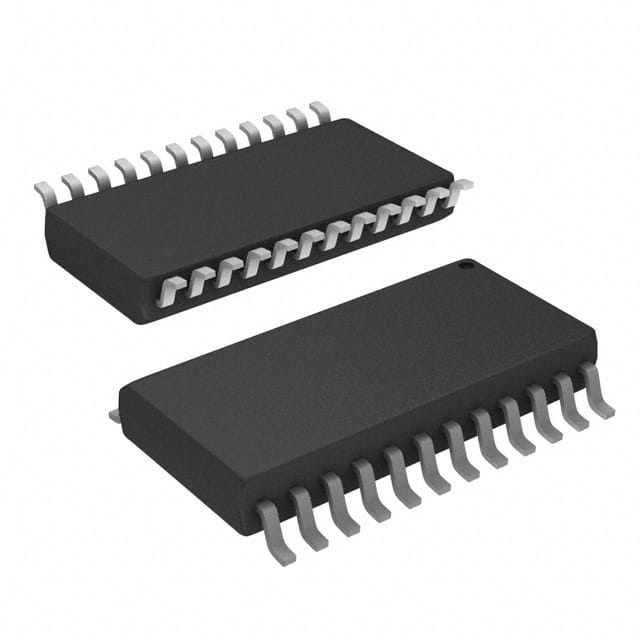Vedi le specifiche per i dettagli del prodotto.

Encyclopedia Entry: 74F676SCX
Product Overview
Category
The 74F676SCX belongs to the category of integrated circuits (ICs).
Use
This IC is commonly used in digital electronics for various applications, including data storage and retrieval.
Characteristics
- The 74F676SCX is a high-speed, octal D-type flip-flop with transparent inputs.
- It operates on a wide voltage range, typically between 4.5V and 5.5V.
- This IC offers excellent noise immunity and low power consumption.
- It is designed to provide reliable and efficient data storage and transfer capabilities.
Package
The 74F676SCX is available in a small outline integrated circuit (SOIC) package.
Essence
The essence of the 74F676SCX lies in its ability to store and manipulate digital information effectively.
Packaging/Quantity
This IC is typically packaged in reels or tubes, containing a specific quantity per package, such as 250 or 1000 units.
Specifications
- Supply Voltage Range: 4.5V to 5.5V
- Operating Temperature Range: -40°C to +85°C
- Input Voltage High Level (VIH): 2V to VCC
- Input Voltage Low Level (VIL): GND to 0.8V
- Output Voltage High Level (VOH): 2.4V (min)
- Output Voltage Low Level (VOL): 0.4V (max)
- Propagation Delay Time: 7 ns (typical)
Detailed Pin Configuration
The 74F676SCX has a total of 20 pins, each serving a specific function. Here is the detailed pin configuration:
- CLR (Clear)
- CP (Clock Pulse)
- D0 (Data Input 0)
- D1 (Data Input 1)
- D2 (Data Input 2)
- D3 (Data Input 3)
- D4 (Data Input 4)
- D5 (Data Input 5)
- D6 (Data Input 6)
- D7 (Data Input 7)
- Q0 (Flip-Flop Output 0)
- Q1 (Flip-Flop Output 1)
- Q2 (Flip-Flop Output 2)
- Q3 (Flip-Flop Output 3)
- Q4 (Flip-Flop Output 4)
- Q5 (Flip-Flop Output 5)
- Q6 (Flip-Flop Output 6)
- Q7 (Flip-Flop Output 7)
- GND (Ground)
- VCC (Power Supply)
Functional Features
- The 74F676SCX operates as an octal D-type flip-flop with transparent inputs.
- It can store and transfer data on the rising edge of the clock pulse.
- The clear input (CLR) allows for resetting all flip-flops to a known state.
- This IC provides individual output enable control for each flip-flop.
Advantages and Disadvantages
Advantages
- High-speed operation enables efficient data processing.
- Excellent noise immunity ensures reliable performance.
- Low power consumption contributes to energy efficiency.
- Wide voltage range compatibility enhances versatility.
Disadvantages
- Limited number of flip-flops (8 in total) may restrict certain applications requiring more storage capacity.
- Availability and pricing may vary depending on market demand.
Working Principles
The 74F676SCX functions by utilizing flip-flops to store and manipulate digital information. When the clock pulse is triggered, the data inputs are transferred to the corresponding flip-flop outputs. The transparent inputs allow for real-time data transfer, while the clear input resets all flip-flops to a known state. This IC operates on a specific voltage range and provides reliable data storage capabilities.
Detailed Application Field Plans
The 74F676SCX finds applications in various digital systems, including but not limited to: - Data storage and retrieval systems - Microcontrollers and microprocessors - Communication devices - Industrial automation systems - Control systems
Detailed and Complete Alternative Models
Here are some alternative models that offer similar functionality to the 74F676SCX: - 74HC676: High-speed octal D-type flip-flop with transparent inputs. - 74LS676: Low-power octal D-type flip-flop with transparent inputs. - CD4013: Dual D-type flip-flop with complementary outputs.
These alternative models can be considered based on specific requirements and availability.
In conclusion, the 74F676SCX is a high-speed octal D-type flip-flop with transparent inputs. It offers excellent noise immunity, low power consumption, and reliable data storage capabilities. This IC finds applications in various digital systems
10 domande e risposte comuni relative all'applicazione di 74F676SCX nelle soluzioni tecniche
Sure! Here are 10 common questions and answers related to the application of 74F676SCX in technical solutions:
Q: What is the 74F676SCX? A: The 74F676SCX is a quad latch with transparent enable, commonly used in digital circuits for data storage and transfer.
Q: What is the maximum operating voltage for the 74F676SCX? A: The maximum operating voltage for the 74F676SCX is typically 5.5V.
Q: How many latch outputs does the 74F676SCX have? A: The 74F676SCX has four latch outputs, allowing it to store and output four separate bits of data.
Q: Can the 74F676SCX be used in high-speed applications? A: Yes, the 74F676SCX is designed for high-speed operation and can be used in applications that require fast data transfer.
Q: Does the 74F676SCX have an internal clock? A: No, the 74F676SCX does not have an internal clock. It relies on external clock signals for its operation.
Q: What is the power supply range for the 74F676SCX? A: The power supply range for the 74F676SCX is typically between 4.5V and 5.5V.
Q: Can the 74F676SCX be cascaded to increase the number of latch outputs? A: Yes, multiple 74F676SCX chips can be cascaded together to increase the number of latch outputs in a circuit.
Q: What is the typical propagation delay of the 74F676SCX? A: The typical propagation delay of the 74F676SCX is around 6 nanoseconds.
Q: Can the 74F676SCX be used in both parallel and serial data transfer applications? A: Yes, the 74F676SCX can be used in both parallel and serial data transfer applications, depending on the circuit configuration.
Q: Is the 74F676SCX compatible with other logic families? A: Yes, the 74F676SCX is compatible with a wide range of logic families, including TTL and CMOS, making it versatile for various applications.
Please note that these answers are general and may vary based on specific datasheet specifications and application requirements.

